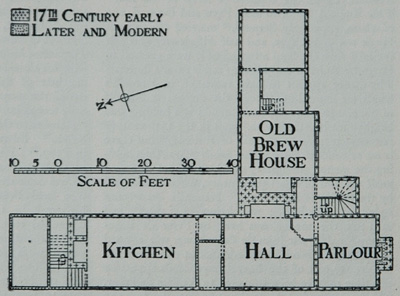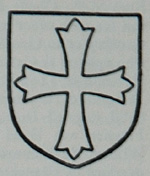A History of the County of Hertfordshire Volume 4 - Layston pages 77 to 88

The main block, which faces west, is 71 ft. 6 in. long, exclusive of a lean-toat the northend, in which is a modern stair ; the  width is 17 ft. (39) The doorway is nearly central and opens into a modern passage leading to a doorwayon the east front; this passage, which is not now a through passage, occupies the position of the former screens. On the south side is the stone-paved hall, with a wide seated fireplace on the east side; beyond is the parlour, also with a wide fireplace, partly blocked. On the north side of the entrance is a large kitchen with a wide fireplace at the north end. A short passage from the hall leads to the east wing, which contains the old brew-house, &c; a small inclosed staircase projecting in the angle between the east wing and the shorter arm of the cross is entered from this passage. The ends of the main block, east wing and stair inclosure are gabled. The brick chimney stacks have groups of plain square shafts set diagonally; the windows have plain wooden mullions and frames and appear to be of 17th-century date. The fireplace in the hall has a three-centred arch; two of the rooms on the upper floor have fire¬places with four-centred moulded arches. In several of the rooms is panelling of 17th-century date and also some of the early 18th century, bolection moulded ; some of the panels over the fireplaces inclose old oil paintings.
width is 17 ft. (39) The doorway is nearly central and opens into a modern passage leading to a doorwayon the east front; this passage, which is not now a through passage, occupies the position of the former screens. On the south side is the stone-paved hall, with a wide seated fireplace on the east side; beyond is the parlour, also with a wide fireplace, partly blocked. On the north side of the entrance is a large kitchen with a wide fireplace at the north end. A short passage from the hall leads to the east wing, which contains the old brew-house, &c; a small inclosed staircase projecting in the angle between the east wing and the shorter arm of the cross is entered from this passage. The ends of the main block, east wing and stair inclosure are gabled. The brick chimney stacks have groups of plain square shafts set diagonally; the windows have plain wooden mullions and frames and appear to be of 17th-century date. The fireplace in the hall has a three-centred arch; two of the rooms on the upper floor have fire¬places with four-centred moulded arches. In several of the rooms is panelling of 17th-century date and also some of the early 18th century, bolection moulded ; some of the panels over the fireplaces inclose old oil paintings.
Layston House, to the south of the village, is the residence of Mrs. A. E. Tollemache.
In the south of the parish is Hailey Hill (Heylee, xiii cent.), which gave its name to a family holding lands in the parish in the 13th and 14th centuries.(40) Further east is the farm called Owles, a name which seems to be a phonetic rendering of the first syllable of Alswick. The house has been rebuilt and no ancient features remain.
In 1623 there is record of a house called Bolton Hall in Layston, which at that date was sold by William Wood of Thrist co. Kent, surgeon, to Benjamin Henshawe of London.(41) On the south it abutted on Baldock Lane and on the east on the way leading from the Bell Inn to Baldock Lane.
Seth Ward (1617-89), the founder of Ward's Hospital, was born at Aspenden in 1617 and was educated at the grammar school in Buntingford. He was expelled from Cambridge for contributing to a book against the Solemn League and Covenant, and he then returned to his native place and was tutor for some years to the sons of Ralph Freeman of Aspenden Hall. In 1649 he became a professor at Oxford and was one of the original members of the Royal Society. He was made Bishop of Oxford in 1662 and in 1667 was translated to Salisbury. He built the almshouses in Buntingford five years before his death in 1689.(42)
Another bishop who was connected by birth with Buntingford is James Henry Monk (1784—1851), who was born there in 1784. In 1809 Monk became Regius Professor of Greek at Cambridge. He was appointed Dean of Gloucester in 1822 and in 1830 became Bishop of Gloucester. (43)
Sir John Watts, son of Thomas Watts of Buntingford, was a famous merchant and shipowner in the 16th century. He owned a ship that fought against the Spanish Armada and served on her himself. In 1590 he successfully engaged with Spanish ships near Madrid. To the King of Spain he was described as one of ' the greatest pirates that ever had been in this kingdom.' He was one of the founders of the East India Company, of which he was elected governor in 1601, and was also a member of the Virginian Company. He was Lord Mayor of London 1606—7 and died in 1616.(44) Thomas Hobson (1544 ?—1631), the carrier of Cambridge, whose business methods are said to have given rise to the proverb ' Hobson's choice,' was also born at Buntingford. (45)
Daniel Langhorne, the antiquary, was appointed vicar of Layston in 1671 and held the living until his death in 1681.(46)
39 These are external dimensions. 40 Robert de Hailey was assessed for subsidies in 1296 and 1307 (Lay Subs. R. bdle. 120, no. 5, 8). Nicholas son of Robert de Hailey, called of Epping, granted his lands in the parish to Robert atte Water of Ware for life in 1348 (Cal. Close, 1346-9, p. 513). Joan widow of John |
Hotoft died seised of a tenement called Heylees near Buntingford in 1446 (Chan. Inq. p.m. 24 Hen. VI, no, 31). 41 Com.Pleas D.Enr.Hil. 21 Jas.I, m. 1. 42 Dict, Nat, Biog,; East Herts, Arch, Soc, Trans iii, 220. |
43 Dict, Nat, Biog, 44 Ibid. In 1602 he conveyed the rent of a house in Buntingford to trustees for the poor of the town (Close, 45 Eliz. pt xii). 45 Dict, Nat, Biog, 46 Ibid. |
 | Select page number: Page 81 |  |
